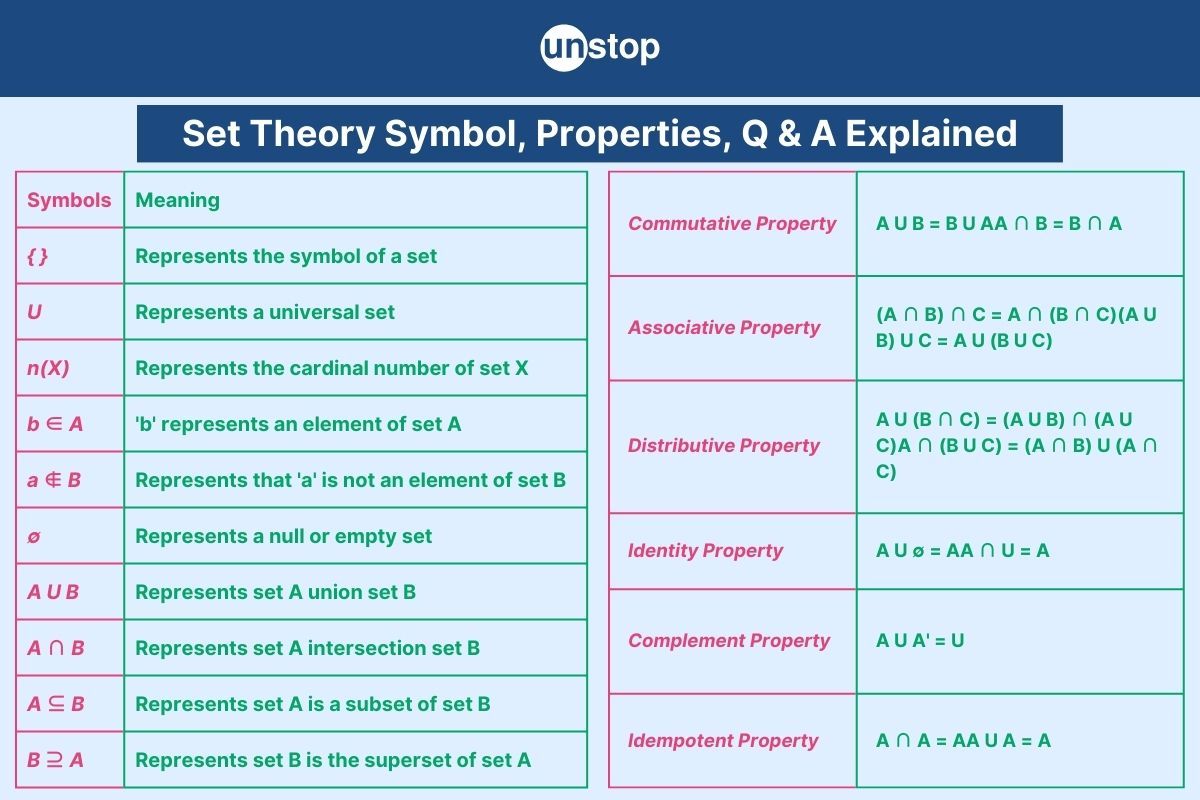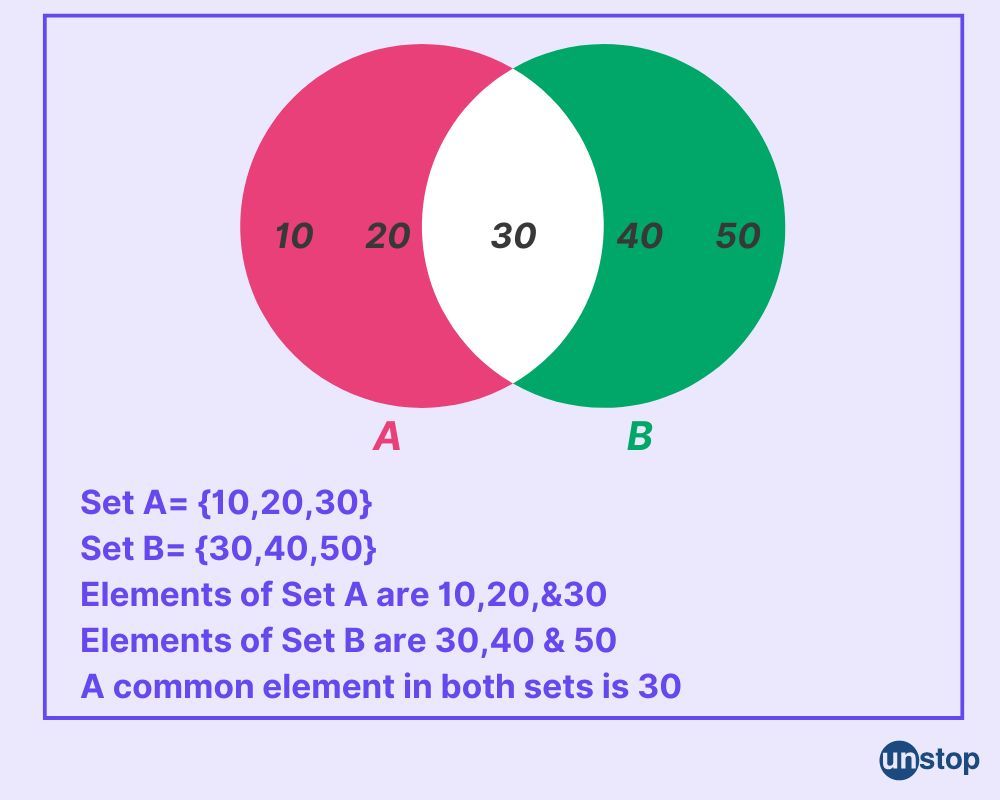- Definition Of A Set In Set Theory
- History Of Set Theory
- Representation Of Sets
- Symbol Usage In Set
- Types Of Sets
- Properties Of Sets
- Formulas Of Sets
- Using Venn Diagram To Represent Sets
- De Morgan Law Of Set
- Practice Questions & Answers Of Set Theory
- Conclusion
- Frequently Asked Questions (FAQs)
Set Theory- Definition, Type, Formula, Practice Question & Answer

Set Theory, a logical branch of mathematics, explores collections of objects and the operations performed on them. This article explores the concept of set theory and provides a detailed examination of sets.
Definition Of A Set In Set Theory
In set theory, a set is a well-defined collection of distinct objects considered as a single entity. Elements or members of a set can be diverse, including numbers, letters, colours, or even other sets. These items are referred to as the objects within a set.
In set theory, sets are defined solely by their elements and not by the order in which the elements are listed or how many times an element appears.

History Of Set Theory
Georg Cantor, often seen as the pioneer of set theory, brought forth the notion of sets as groups of unique items with clear characteristics. He explored various forms of infinity and famously demonstrated that the set of real numbers is infinitely vast.
Richard Dedekind also played a key role in shaping set theory through the introduction of Dedekind cuts, a method used to define real numbers using sets.
Representation Of Sets
In set theory, sets can be represented using various notations that differ in how elements are listed. There are three common set notations: Semantic form, Roster form, and Set builder form.
| Semantic Form | Roster Form | Set Builder Form |
| A set of first odd natural numbers | {1,3,5,7,9} | {x ∈ ℕ | x <10 and x is odd} |
The elements of a set are depicted in a statement through semantic form. Roster form means listing the elements inside curly brackets with commas between them. The set builder form defines a rule that explains what all the elements in a set have in common.
Symbol Usage In Set
Symbols in set theory are utilized to define elements within a specific set. The table below illustrates various set theory symbols along with their corresponding meanings.
| Symbols | Meaning |
|---|---|
| { } | Represents the symbol of a set |
| U | Represents a universal set |
| n(X) | Represents the cardinal number of set X |
| b ∈ A | 'b' represents an element of set A |
| a ∉ B | Represents that 'a' is not an element of set B |
| ∅ | Represents a null or empty set |
| A U B | Represents set A union set B |
| A ∩ B | Represents set A intersection set B |
| A ⊆ B | Represents set A is a subset of set B |
| B ⊇ A | Represents set B is the superset of set A |
Types Of Sets
The set theory encompasses various categories of sets, including singleton sets, finite sets, infinite sets, and empty sets.
Singleton Set
A set containing just one item is known as a singleton set or unit set. To illustrate, consider Set A = { k | k is an integer between 7 and 9}, which in this case equals A = {8}.
Finite Set
A set that contains a limited or countable number of elements is known as a finite set. For instance, consider Set B, where B is the collection of prime numbers less than 20: B = {2, 3, 5, 7, 11, 13, 17, 19}.
Infinite Set
An infinite set is one that has countless elements, like set C, which contains multiples of 4.
Empty Or Null Set
An empty set, also known as a null set, is a set that contains no elements. It is represented by the symbol '∅'. For instance, consider the set X = { }.
Equal Set
If two sets contain the same elements, they are known as equal sets. For instance, if A = {4,812} and B = {4,8,12}, then A and B are considered equal. This relationship can be shown as A = B.
Unequal Set
If two sets contain even one different element, they are considered unequal. For instance, if A = {1,2,3} and B = {2,3,4}, then A and B are not equal. In mathematical terms, this inequality is denoted as A ≠ B.
Equivalent Set
Equivalent sets are sets that have the same number of elements, even if the elements themselves are different. For instance, if set A contains {1,2,3,4} and set B contains {a,b,c,d}, they are considered equivalent because they both have the same number of elements.
Overlapping Set
When two sets share at least one common element, they are considered overlapping. For instance, in set A with elements {2,4,6} and set B with elements {4,8,10}, the presence of element 4 in both sets signifies their overlap.
Disjoint Set
Two sets are considered disjoint when they do not share any common elements. For instance, if A = {1,2,3,4} and B = {5,6,7,8}, then sets A and B are said to be disjoint.
Subset & Superset
When looking at two sets, A and B, if all the items in set A are also found in set B, then we say that A is a subset of B (A ⊆ B), and in this situation, B is known as the superset of A (B ⊇ A).
For instance, let's take the sets A = {1,2,3} and B = {1,2,3,4,5,6}. This can be represented as,
-
Set A is a subset of set B, denoted by A being a part of B, as all elements in A are also found in B.
-
Set B containing set A means that set B is larger than set A.
Universal Set
The letter 'U' represents the universal set, which includes all elements related to a specific topic.
Imagine a grocery store with a collection of fruits, all fitting under the umbrella of a universal set known as U. This set can be further broken down into smaller groups that highlight particular categories of fruits.
-
The set of citrus fruits includes oranges, lemons, and grapefruits.
-
The set of berries includes strawberries, blueberries, and raspberries.
-
The set of tropical fruits includes pineapples, mangoes, and papayas.
Power Set
The power set is a collection of all possible subsets that can be found within a given set. For instance, if we have a set A with elements {1,2,3}, then the power set of A would include {∅, {1}, {2}, {3}, {1,2}, {2,3}, {1,3}, {1,2,3}}.
Properties Of Sets
Sets, just like numbers, also exhibit properties such as associative and commutative properties. There are six key properties that sets possess when considering three sets A, B, and C.
| Commutative Property | A U B = B U A A ∩ B = B ∩ A |
| Associative Property | (A ∩ B) ∩ C = A ∩ (B ∩ C) (A U B) U C = A U (B U C) |
| Distributive Property | A U (B ∩ C) = (A U B) ∩ (A U C) A ∩ (B U C) = (A ∩ B) U (A ∩ C) |
| Identity Property | A U ∅ = A A ∩ U = A |
| Complement Property | A U A' = U |
| Idempotent Property | A ∩ A = A A U A = A |
Formulas Of Sets
Sets are widely used in algebra, statistics, and probability. Set theory formulas play a crucial role in this mathematical concept.
For any two overlapping sets, A and B,
-
n(A U B) = n(A) + n(B) - n(A ∩ B)
-
n (A ∩ B) = n(A) + n(B) - n(A U B)
-
n(A) = n(A U B) + n(A ∩ B) - n(B)
-
n(B) = n(A U B) + n(A ∩ B) - n(A)
-
n(A - B) = n(A U B) - n(B)
-
n(A - B) = n(A) - n(A ∩ B)
For any two sets A and B that are disjoint,
-
n(A U B) = n(A) + n(B)
-
A ∩ B = ∅
-
n(A - B) = n(A)
Using Venn Diagram To Represent Sets
A Venn diagram shows sets using circles, each containing elements. The circles may be enclosed in a rectangle to represent the universal set. The diagram below illustrates the relationships between the sets:

De Morgan Law Of Set
De Morgan's Law in set theory helps us understand how the complement of two sets relates to their union and intersection. There are two specific laws that fall under De Morgan's Law. Let's explore them briefly.
Law Of Union
When you combine two sets and find the opposite, that's De Morgan's Law of Union. It means the opposite of putting sets together equals finding the opposite of each set separately and putting them together. In math, it looks like: (A ∪ B)’ = A’ ∩ B’
Law Of Intersection
De Morgan's Law of Intersection explains that when you find the complement of two sets intersecting, it equals the complement of each set separately combined. This rule can be written mathematically as follows: (A ∩ B)’ = A’ ∪ B’
Click here to learn more about various topics related to quantitative aptitude, including a detailed explanation of the section related to set theory!
Practice Questions & Answers Of Set Theory

Question 1: If A = {1, 2, 3} and B = {2, 3, 4}, what is A ∩ B?
a) {1, 4}
b) {2, 3}
c) {1, 2, 3, 4}
d) {}
Answer: b) {2, 3}
Explanation: The intersection of two sets is the set of elements that are common to both sets.
Question 2: If A = {1, 2, 3} and B = {2, 3, 4}, what is A ∪ B?
a) {1, 4}
b) {2, 3}
c) {1, 2, 3, 4}
d) {}
Answer: c) {1, 2, 3, 4}
Explanation: The union of two sets is the set of elements that are in either set.
Question 3: If A = {1, 2, 3} and B = {2, 3, 4}, what is A - B?
a) {1}
b) {2, 3}
c) {4}
d) {}
Answer: a) {1}
Explanation: The difference between the two sets is the set of elements that are in the first set but not in the second.
Question 4: If A = {1, 2, 3} and B = {2, 3, 4}, what is B - A?
a) {1}
b) {2, 3}
c) {4}
d) {}
Answer: c) {4}
Explanation: The difference between the two sets is the set of elements that are in the first set but not in the second.
Question 5: If A = {1, 2, 3} and B = {4, 5, 6}, are A and B disjoint?
a) Yes
b) No
c) Maybe
d) It depends
Answer: a) Yes
Explanation: Two sets are disjoint if they have no elements in common.
Question 6: If A = {1, 2, 3} and B = {2, 3, 4}, are A and B disjoint?
a) Yes
b) No
c) Maybe
d) It depends
Answer: b) No
Explanation: Two sets are disjoint if they have no elements in common.
Question 7: Consider three sets A = {1, 2, 3}, B = {2, 3, 4}, and C = {3, 4, 5}. What is (A ∪ B) ∩ C?
a) {2, 3}
b) {3, 4}
c) {4, 5}
d) {2, 3, 4}
Answer: b) {3, 4}
Explanation: First, find the union of sets A and B, which is {1, 2, 3, 4}. Then, find the intersection of this set with set C. The result is {3, 4}.
Question 8: Let A = {1, 2, 3, 4, 5}, B = {4, 5, 6, 7, 8}, and C = {1, 3, 5, 7, 9}. What is (A ∩ B) ∪ C?
a) {1, 2, 3, 4, 5, 6, 7, 8, 9}
b) {1, 3, 4, 5, 7, 9}
c) {1, 3, 5, 7, 9}
d) {4, 5}
Answer: b) {1, 3, 4, 5, 7, 9}
Explanation: First, find the intersection of sets A and B, which is {4, 5}. Then, find the union of this set with set C. The result is {1, 3, 4, 5, 7, 9}.
Question 9: Let A = {1, 2, 3, 4, 5}, B = {4, 5, 6, 7, 8}, and C = {1, 3, 5, 7, 9}. What is (A - B) ∩ C?
a) {1, 3}
b) {1, 2, 3}
c) {1, 3, 5, 7, 9}
d) {1, 5}
Answer: a) {1, 3}
Explanation: First, find the difference of sets A and B, which is {1, 2, 3}. Then, find the intersection of this set with set C. The result is {1, 3}.
Question 10: If A = {1, 2, 3, 4, 5} and B = {6, 7, 8, 9, 10}, what is the cardinality of A ∩ B?
a) 0
b) 1
c) 2
d) 3
Answer: a) 0
Explanation: The intersection of two sets is the set of elements that are common to both sets. Here, there are no common elements, so the cardinality is 0.
Conclusion
In conclusion, set theory is a foundational branch of mathematics that provides a framework for understanding relationships between objects. By defining sets and operations such as union and intersection, set theory allows us to analyze complex systems and solve problems in various fields.
Its applications are vast, from computer science to physics, demonstrating the importance of this fundamental concept in mathematics.
Frequently Asked Questions (FAQs)
1. Define set theory and its importance in mathematics.
Set theory is a branch of mathematics that deals with the study of sets, which are collections of objects. It provides a foundation for other mathematical disciplines and is essential for understanding concepts like functions, relations, and number systems.
2. How can set theory help me in real-life applications?
Set theory is used in various fields such as computer science, statistics, and logic. It helps in organizing data, solving problems related to grouping and categorization, and making decisions based on relationships between different elements.
3. What are the basic concepts in set theory?
Some basic concepts in set theory include elements, subsets, unions, intersections, and complements. Understanding these concepts will help you navigate through more complex topics within set theory.
4. How can learning set theory improve my problem-solving skills?
Studying set theory can enhance your critical thinking and analytical skills by teaching you how to break down complex problems into smaller, more manageable parts. It also helps in developing logical reasoning and decision-making abilities.
Suggested reads:
- What Is Mode- Definition, Formula, Practice Questions & Answers
- Syllogism- Definition, Types, Rules, Practice Questions & Answers
- Variance- Definition, Formula, Selected Practice Question & Answer
- Number System In Maths- Types, Conversion, Questions And Answers
- What Is Range- Formula & Calculation Explained (Question & Answer)
Instinctively, I fall for nature, music, humor, reading, writing, listening, traveling, observing, learning, unlearning, friendship, exercise, etc., all these from the cradle to the grave- that's ME! It's my irrefutable belief in the uniqueness of all. I'll vehemently defend your right to be your best while I expect the same from you!
Login to continue reading
And access exclusive content, personalized recommendations, and career-boosting opportunities.
Subscribe
to our newsletter
















Comments
Add comment